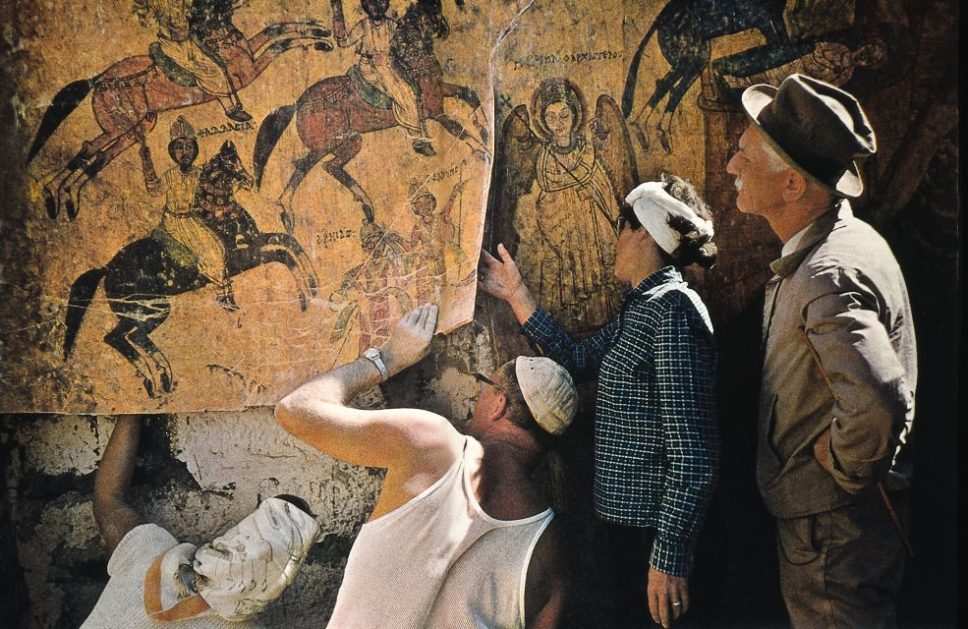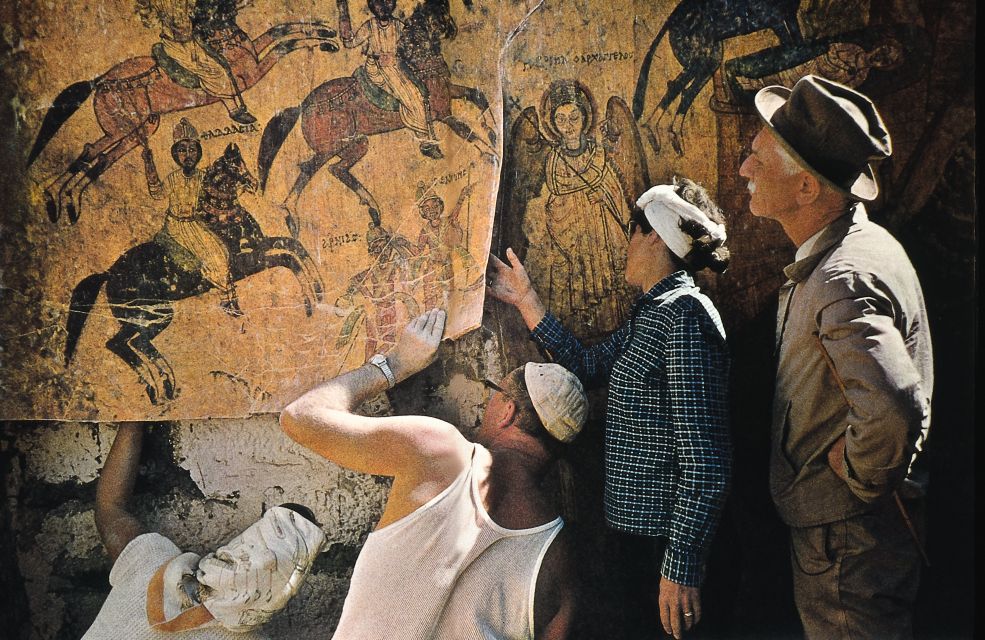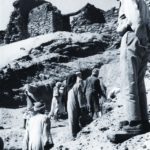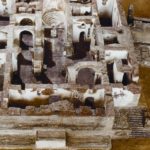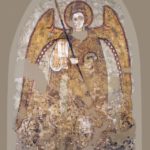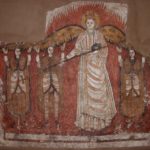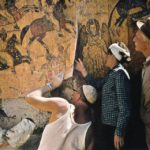Faras
Pachoras
-
Nazwa projektu:
Międzynarodowa Kampania Ratowania Zabytków Nubii (pod auspicjami UNESCO)
The International Campaign to Safeguard the Monuments of Nubia (coordinated by UNESCO)
-
Typ stanowiska:
Ośrodek religijny – katedra
Lokalizacja:
Sudan
Nubia, stolica królestwa NobadiiDatowanie:
VII–XIV wiek
Najciekawsze odkrycia:
– kościół z cegły mułowej – najstarsza budowla w obrębie fortyfikacji
– pierwsza katedra z VII wieku n.e.
– 169 malowideł ściennych, wykonanych techniką tempery na suchym tynku
– ok 750 inskrypcji w językach greckim, staronubijskim i koptyjskim
– lista biskupów Faras: obok imion hierarchów zaznaczano na niej także liczbę lat sprawowania przez każdego z nich urzędu biskupiego
– bloki z budowli faraońskich: Totmesa III i Ramzesa II (pochodzące z oddalonej o 50 km na południe świątyni w Buhen)
– tablica fundacyjna z 707 roku n.e., wymieniająca króla Makurii Mekuriosa
– stele komemoratywne z inskrypcjami w języku greckim i koptyjskim
Historia badań:
Badane przez misję CAŚ UW w latach:
1961–1964
Typ badań:
badania wykopaliskowe, badania ratunkowe, prace konserwatorskie
Kierownicy badań:
Kazimierz Michałowski
Instytucje współpracujące:
– Centrum Archeologii Śródziemnomorskiej Uniwersytetu Warszawskiego
– Muzeum Narodowe w Warszawie
– Sudan Antiquities Service
Informacje dodatkowe:
Na początku XX wieku badania w Faras prowadzone były przez misję brytyjską pod kierunkiem Francisa Griffitha. Prace polskiej misji archeologicznej prowadzone były w ramach międzynarodowej Kampanii Nubijskiej. Badania te zainicjowane zostały przez UNESCO w związku z budową Wysokiej Tamy Asuańskiej. Obecnie stanowisko zalane jest wodami sztucznego Jeziora Nasera.
Opis stanowiska i badań:
Odkrycie w Faras katedry z dobrze zachowanymi malowidłami ściennymi w międzynarodowej prasie nazwane zostało „Cudem z Faras”. Na kompleks katedralny składają się obiekty sakralne nazwane imionami biskupów, którzy zlecili ich budowę: Aetiosa, Paulosa i Petrosa.
Malowidła:
W katedrze odkryto 169 malowideł ściennych wykonanych techniką tempery na suchym tynku. Zabytki te są największym znalezionym zespołem chrześcijańskiego malarstwa nubijskiego i prezentują jego rozwój od VIII do XIII wieku. W ramach prac ratunkowych w katedrze zdjęto ze ścian 120 malowideł, przy czym 66 z nich zostało przetransportowanych do Muzeum Narodowego w Warszawie – tamtejsza Galeria Faras to jedyna w Europie i wyjątkowa w skali świata ekspozycja zabytków chrześcijańskiej sztuki nubijskiej z VIII–XIV wieku. Pozostała część malowideł trafiła do Muzeum Narodowego w Chartumie. Obie galerie zostały otwarte w 1972 roku; w 2014 roku galeria w MNW została przebudowana i udostępniona w nowej odsłonie.
Wśród przedstawień umieszczonych na malowidłach znajdują się:
– wizerunki archaniołów, przede wszystkim Michała, który w katedrze faraskiej ma kilkanaście przedstawień;
– Matka Boska, ukazana w różnych schematach ikonograficznych – tronująca, stojąca, na ogół z Dzieciątkiem;
– apostołowie, z których Jan i Piotr są najpopularniejsi;
– przedstawienia lokalnych świętych, np. św. Amoniusza, czy jedyny na świecie portret św. Kaau;
– trzy obowiązkowe sceny: Boże Narodzenie według schematu bizantyjskiego (z wizytą trzech magów na koniach, Matką Boską na łożu i Chrystusem w murowanym na kształt stajenki żłóbku), Pasja ze Złożeniem do Grobu oraz Trzej Młodziankowie w Piecu Ognistym.
W późnym okresie funkcjonowania katedry na jej ścianach malowano głównie ówczesnych dostojników.
Lista Biskupów Faras:
Dla historyków najcenniejszym znaleziskiem jest lista biskupów Faras: obok imion hierarchów zaznaczano na niej także liczbę lat sprawowania przez każdego z nich urzędu biskupiego, dzięki czemu, w oparciu o inne dokumenty, można było obliczyć daty poszczególnych episkopatów, co z kolei umożliwiło ustalenie czasu powstania wielu malowideł (lista biskupów Faras została przepisana ze starszego dokumentu w roku 902 i kontynuowana na bieżąco do roku 1169).
Kalendarium:
– bloki z budowli faraońskich: Totmesa III i Ramzesa II;
– kościół z cegły mułowej, potem pierwsza katedra z VII wieku n.e.;
– 620 r.: na ruinach wcześniejszego kościoła Biskup Aetios wznosi najstarszą budowlę katedralną w Faras, na ruinach wcześniejszego kościoła;
– 707 r.: rozpoczęcie przebudowy faraskiej katedry przez biskupa Paulosa, w VIII wieku powstają najstarsze malowidła ścienne w katedrze;
– lata 903–923: Biskup Kolluthos pokrywa ściany katedry nowym tynkiem i zamawia wykonanie nowej dekoracji malarskiej;
– lata 974–997: przebudowa katedry przez biskupa Petrosa. Płaskie stropy zastąpiono ceglanymi sklepieniami kolebkowymi i kopułami wspartymi na filarach, powstają nowe malowidła. Wystrój kontynuują następcy Petrosa, biskupi Joannes i Marianos (1005 r.);
– lata 1293–1304: najazdy Mameluków z Egiptu oraz wewnętrzne walki o władzę doprowadzają do osłabienia i upadku chrześcijańskiej Makurii. Islam wypiera chrześcijaństwo z Nubii, katedra popada w ruinę, gruzy świątyni zasypuje pustynny piach;
– Na szczycie komu powstałego w miejscu ruin katedry powstaje arabska cytadela, wzniesiona zapewne w XVII wieku.
Wydarzenia związane z projektem (wybór):
- 2017 Spotkanie i promocja książki: „Twarze Nubii — Stefanowi”
- 2015 Honorowe wyróżnienie Media&Technology MUSE Award dla prezentacji Faras 3D
- 2014 Nagroda Sybilla dla Galerii Faras w kategorii Wystawy Historyczne i Archeologiczne
- 2014 Uroczyste otwarcie Galerii Faras im. Profesora Kazimierza Michałowskiego
- 2014 Seminarium IKŚiO PAN: Problem datowania wczesnych malowideł z Faras
- 2011 50-lecie Akcji nubijskiej: odznaczenia dla polskich archeologów za ratowanie dziedzictwa Nubii
- 2011 Seminarium IKŚiO PAN: 50 lat po Faras
- 2006 Stulecie urodzin Kazimierza Michałowskiego
- 2006 Wystawa: Profesor Kazimierz Michałowski i polska szkoła archeologii śródziemnomorskiej
Linki:
- Galeria Faras w Muzeum Narodowym w Warszawie
- Wirtualny spacer po Galerii Faras
- MKiDN Skarby nubijskiej pustyni w MNW – Galeria Faras
W mediach (wybór):
- Otwarcie Galerii Faras na kanale YouTube MNW (MNW, 26.02.2015)
- Galeria Faras. Skarbiec sztuki wykopanej z Pustyni Nubijskiej (Polskie Radio, 19.10.2014)
- Dzień Dobry TVN: Galeria Faras. Najcenniejszy polski skarb (tvn.pl, 18.10.2014)
- Para prezydencka na otwarciu Galerii Faras w Muzeum Narodowym (Prezydent.pl, 17.10.2014)
- Nubijskie skarby z Faras od soboty w nowej odsłonie (tvn24.pl, 16.10.2014)
- W Galerii Faras trwają przygotowania do ponownego otwarcia (Dzieje.pl, 27.08.2014)
- Jak polscy archeolodzy ratowali skarby z Faras? (Gazeta Wyborcza, 18.10.2014)
- Skarby Faras ukryte w piaskach pustyni (Culture.pl)
Makowski P., (2019), Trójca Święta pod przedstawieniem Maistas Domini z katedry w Faras, AD REM 3/2019, 22–31
Wozniak M.M., (2019), Études des peintures murales médiévales soudanaises de 1963 à nos jours – Essai d’historiographie, Afriques, Débats, méthodes et terrains d’histoire 10. DOI : https://doi.org/10.4000/afriqu
Jakobielski, S., Martens-Czarnecka, M., Łaptaś, M., Mierzejewska, B., & Rostkowska, B. (2017). Pachoras/Faras. The wall paintings from the Cathedrals of Aetios, Paulos and Petros. Warsaw: PCMA UW; IKŚiO PAN; Muzeum Narodowe w Warszawie.
Górecki, T. (2016). Fragment naczynia z katedry w Faras – relikwiarz czy naczynie na chleby eucharystyczne? [The vessel fragment from Faras cathedral: a reliquary or a vessel for eucharistic bread?]. Rocznik Muzeum Narodowego w Warszawie, 130–141.
Jakobielski, S. (2016). Chronologia wczesnych malowideł ściennych z katedry w Faras (VIII-IX wiek) (=Paideia studia archeologiczne i orientalistyczne), Warsaw: IKŚiO PAN.
Jakobielski, S. (2016). The murals on entrance porch of the Faras Cathedral. Études et Travaux, 29, 75–94.
Makowski P., (2016), In Search of Nubian Master-Builders: An Architectural Drawing from the Cathedral in Faras (with an appendix: Prayer of a young woman by van Gervern Oei V.), Polish Archaeology in the Mediterranean 25, 809–833 DOI: 10.5604/01.3001.0010.3017
Jakobielski, S. (2014). Malowidła z Faras. Pół wieku po odkryciu [Wall paintings from Faras. Half a century after discovery]. In S. Szafrański (Ed.), Sztuka Afryki w kolekcjach i badaniach polskich (pp. 253–280). Szczecin: Muzeum Narodowe.
Mierzejewska, B. (2014). Galeria Faras im. Profesora Kazimierza Michałowskiego: przewodnik [Guide to the Professor Kazimierz Michałowski Faras Gallery]. Warsaw: Muzeum Narodowe.
Mierzejewska, B. (2014). The Professor Kazimierz Michałowski Faras Gallery: Guidebook. Warsaw: National Museum in Warsaw.
Sulikowska, A., & Mierzejewska, B. (2014). Exhibition Room VI. Wall paintings from Faras Cathedral. In B. Mierzejewska, The Professor Kazimierz Michałowski Faras Gallery: Guidebook (pp. 106–197). Warsaw: National Museum.
Godlewski, W., & Łajtar, A. (2013). Faras. In Voices from the Nile Valley: Polish archaeology between Alexandria and Dongola. Warsaw: Warsaw University Press.
Jakobielski, S. (2013). Faras. In D. Bagińska (Ed.), Wielkie królestwa chrześcijańskie w Nubii / The great Christian kingdoms of Nubia (pp. 15–19). Poznań: Muzeum Archeologiczne w Poznaniu.
Jakobielski, S. (2013). Katedra w Faras / Faras Cathedral. In D. Bagińska (Ed.), Wielkie królestwa chrześcijańskie w Nubii / The great Christian kingdoms of Nubia (pp. 20–29). Poznań: Muzeum Archeologiczne w Poznaniu.
Mierzejewska, B. (2013). Malowidła ścienne z Faras [Wall paintings from Faras]. In A. Morawińska & R. Higersberger (Eds.), Skarby sztuki: Muzeum Narodowe w Warszawie (pp. 42–49). Warsaw: Arkady.
Szymańska, A. (2010). Liminal bishops: Episcopal portraits from the Cathedral of Pachoras, Nubia (Unpubl. MA thesis, Temple University, Philadelphia). Retrieved from http://cdm16002.contentdm.oclc.org/cdm/ref/collection/p245801coll10/id/86848
Łajtar, A. (2009). Varia Nubica XIII: Die Titulatur des Königs Moüses Georgios nach einer Wandinschrift aus der Faras-Kathedrale In A. Łajtar, Varia Nubica XII–XIX. Journal of Juristic Papyrology, 39, 89–97.
Łajtar, A. (2009). Varia Nubica XVIII: Ein Gebet an Erzengel Raphael aus der Kathedrale zu Faras In A. Łajtar, Varia Nubica XII–XIX. Journal of Juristic Papyrology, 39, 111–115.
Godlewski, W. (2008). Bishops and kings. The official program of the Pachoras (Faras) Cathedrals. In W. Godlewski & A. Łajtar (Eds.), Between the cataracts: Proceedings of the 11th Conference for Nubian studies, Warsaw University, 27 August – 2 September 2006, I. Main papers (pp. 263–282). Warsaw: Warsaw University Press.
D’Achille, A. M. (2007). Un problema di iconografia trinitaria tra Oriente e Occidente: l’affresco di Vallepietra e le immagini di Faras (Nubia). Convergenze poligenetiche o emergenze corradicali? In A. C. Quintavalle (Ed.), Medioevo mediterraneo: l’Occidente, Bisanzio e l’Islam. Atti del convegno internazionale di studi, Parma, 21-25 settembre 2004 (pp. 511–524). Milan: Electa.
Jakobielski, S. (2007). Nubian scenes of protection from Faras as an aid to dating. Études et Travaux, 21, 43–51.
van der Vliet, J. (2007). Exit Tamer, Bishop of Faras (SB V 8728). Journal of Juristic Papyrology, 37, 185–191.
Godlewski, W. (2006). Pachoras: The cathedrals of Aetios, Paulos and Petros. The architecture. Warsaw: Warsaw University Press.
Adams, W. Y. (2005). The West Bank survey from Faras to Gemai II. Sites of Meroitic and Ballaña age. Oxford: Archaeopress.
Adams, W. Y. (2005). The West Bank survey from Faras to Gemai III. Sites of Christian age. Oxford: Archaeopress.
Mierzejewska, B. (2005). Faras Gallery. The Professor Kazimierz Michałowski Faras Gallery. Warsaw: National Museum.
Łaptaś, M. (2003). Representations of angelic hierarchy in a Nativity scene from Faras cathedral. GAMAR, 2, 137–143.
Górecki, T. (2002). Katalogbeiträge Nrn. 63-80 (129-145). In W. Seipel (Ed.), Faras: die Kathedrale aus dem Wüstensand. Vienna: Kunsthistorisches Museum.
Jakobielski, S. (2002). Die Baugeschichte der Kathedrale. In W. Seipel (Ed.), Faras: die Kathedrale aus dem Wüstensand (pp. 37–40). Vienna: Kunsthistorisches Museum.
Jakobielski, S. (2002). Die Chronologie der Wandmalereien in der Kathedrale von Faras. In W. Seipel (Ed.), Faras: die Kathedrale aus dem Wüstensand (pp. 51–56). Vienna: Kunsthistorisches Museum.
Martens-Czarnecka, M. (2002). Die christliche Malerei in Faras und Dongola. Vernissage. Die Zeitschrift Zur Ausstellung, 13, 26–33.
Mierzejewska, B. (2002). Die Malereien von Faras. In W. Seipel (Ed.), Faras: die Kathedrale aus dem Wüstensand (pp. 41–49). Vienna: Kunsthistorisches Museum.
Mierzejewska, B., & Łaptaś, M. (2002). Katalog. In W. Seipel (Ed.), Faras: die Kathedrale aus dem Wüstensand (pp. 65–99). Vienna: Kunsthistorisches Museum.
Seipel, W. (Ed.). (2002). Faras: die Kathedrale aus dem Wüstensand. Vienna: Kunsthistorisches Museum.
Jakobielski, S. (2001). Tentative d’identification de certaines peintures de Faras. Études et Travaux, 19, 59–79.
Łaptaś, M., & Jakobielski, S. (2001). “Unknown” mural of the Three Youths in a Fiery Furnace from the Faras Cathedral. In W. Bulsza & L. Sadko (Eds.), Ars graeca, ars latina. Studia dedykowane Annie Rożyckiej-Bryzek (pp. 75–85). Cracow: Wydawnictwo Uniwersytetu Jagiellońskiego.
Mierzejewska, B. (2001). Remarks on decoration of the western wall of narthex in the Faras cathedral. Bulletin Du Musée National de Varsovie, 42, 148–163.
Mierzejewska, B. (2001). The Collection of East Christian Art. The Professor Kazimierz Michałowski Faras Gallery. In K. Murawska-Muthesius & D. Folga-Januszewska (Eds.), National Museum in Warsaw: guide: galleries and study collections (pp. 81–92). Warsaw: Muzeum Narodowe w Warszawie.
Scholz, P. O. (2001). Wer war Merkurios der „Bezwinger des Bösen” in der Wandmalerei aus Faras/Pachoras? Ikonizität des Drachentöters im Niltal. Bulletin du Musée National de Varsovie, 42, 164–209.
Godlewski, W. (2000). Początki biskupstwa w Pachoras: katedra Aetiosa [The beginnings of the bishopric of Pachoras. The cathedral of Aetios]. Światowit, 2 (43) Fasc. A, 43–48.
Mierzejewska, B. (1999). Murals in the Bishops’ Chapel, Faras: The visual expression of the ruler’s ideology in Nubia. In S. Emmel, M. Krause, S. G. Richter, & S. Schaten (Eds.), Ägypten und Nubien in spätantiker und christlicher Zeit: Akten des 6. Internationalen Koptologenkongresses, Münster, 20.–26. Juli 1996, I. Materielle Kultur, Kunst und religiöses Leben (pp. 285–295). Wiesbaden: Reichert Verlag.
van der Vliet, J. (1999). The Church of the Twelve Apostles: The earliest cathedral of Faras? Orientalia, 68(1), 84–97.
Mierzejewska, B. (1998). Zbiory Sztuki Wschodniochrześcijańskiej. Galeria Faras im. Profesora Kazimierza Michałowskiego [The Collection of East Christian Art. The Professor Kazimierz Michałowski Faras Gallery]. In K. Murawska-Muthesius & D. Folga-Januszewska (Eds.), Muzeum Narodowe w Warszawie: przewodnik po galeriach, stałych i zbiorach studyjnych (pp. 77–88). Warsaw: Muzeum Narodowe w Warszawie.
Łaptaś, M. (1997). A sphere, an orb or a disc? The object held by the archangels in the Faras Cathedral wall paintings. Bulletin Du Musée National de Varsovie, 38(1–4), 24–42.
Łaptaś, M. (1996). Paintings from the Faras Cathedral. The “colour” classification method. Nubian NoteLet, 2, 1–18.
Godlewski, W. (1995). The Bishopric of Pachoras in the 13th and 14th centuries. In C. Fluck, L. Langener, S. G. Richter, S. Schaten, & G. Wurst (Eds.), Divitiae Aegypti: koptologische und verwandte Studien zu Ehren von Martin Krause (pp. 113–118). Wiesbaden: L. Reichert.
Godlewski, W. (1995). The Paulos Cathedral in Faras (Pachoras) and the question of Byzantine influence. In C. F. Moss & K. Kiefer (Eds.), Byzantine East, Latin West: Art-historical studies in honor of Kurt Weitzmann (pp. 235–243). Princeton, NJ: Department of Art and Archaeology, Princeton University.
Vantini, G. (1994). The Faras mural of the Three Youths in the Fiery Furnace – some observations. In C. Bonnet (Ed.), Études nubiennes: conférence de Genève. Actes du VIIe Congrès international d’études nubiennes, 3–8 septembre 1990, II. Communications (pp. 255–257). Geneva: C. Bonnet.
Godlewski, W., & Zych, I. (1993). Galeria Faras: przewodnik = The Faras Gallery: guide. Warszawa: Muzeum Narodowe.
Godlewski, W. (1992). La frise l’abside de la première Cathédrale de Pachoras (Faras). In P. O. Scholz (Ed.), Orbis Aethiopicus: Studia in honorem Stanislaus Chojnacki natali septuagesimo quinto dicata, septuagesimo septimo oblata (pp. 327–356). Albstadt: K. Schuler.
Godlewski, W. (1992). Some remarks on the Faras Cathedral and its painting. Journal of Coptic Studies, 2, 99–116.
Martens-Czarnecka, M. (1992). Faras paintings of the period between mid 8th and mid 10th centuries. Études et Travaux, 16, 119–134.
Martens-Czarnecka, M. (1992). New look at the wall paintings of the Rivergate Church in Faras. In P. O. Scholz (Ed.), Orbis Aethiopicus: Studia in honorem Stanislaus Chojnacki natali septuagesimo quinto dicata, septuagesimo septimo oblata (pp. 363–383). Albstadt: K. Schuler.
Martens-Czarnecka, M. (1992). Some observations on one of the unpreserved murals from Faras Cathedral. In S. Jakobielski & J. Karkowski (Eds.), 50 years of Polish excavations in Egypt and the Near East: Acts of the Symposium at the Warsaw University 1986 (pp. 217–222). Warsaw: Centre d’archéologie méditerranéenne de l’Académie polonaise des sciences.
Babraj, K. (1990). La symbolique des lettres Γ et H dans l’abside de la Cathédrale de Faras et leur lien avec l’art copte. In W. Godlewski (Ed.), Coptic studies: Acts of the Third International Congress of Coptic Studies, Warsaw, 20–25 August, 1984 (pp. 27–40). Warsaw: PWN.
Balicka-Witakowska, E. (1990). Descente de Croix sur une peinture murale de la cathédrale de Faras. Nubica, 1–2, 459–474.
Górecki, T. (1990). Archangel and Saint Mercurios: New iconographical interpretation of the two murals from Faras Cathedral. Nubica, 1–2, 535–540.
Łukaszewicz, A. (1990). Some remarks on the iconography of anchorites from the Faras Cathedral. Nubica, 1–2, 549–556.
Vantini, G. (1990). The Faras “Golgotha” and the Apocrypha. Nubica, 1–2, 653–659.
Dobrzeniecki, T. (1988). Święta Anna z Faras w Muzeum Narodowym w Warszawie. Symbolika gestu milczenia. Rocznik Muzeum Narodowego w Warszawie, 32, 95–214.
Dobrzeniecki, T. (1987). Nubijska Maiestas Domini z Katedry w Faras w Muzeum Narodowym w Warszawie. Część druga. Rocznik Muzeum Narodowego w Warszawie, 31, 263–390.
Dobrzeniecki, T. (1987). St. Anne from Faras in the National Museum in Warsaw (J. Holzman, Trans.). Bulletin du Musée National de Varsovie, 28(3–4), 46–75.
Galavaris, G. (1986). Observations on the iconography of a Faras “Majestas” and its relatives. In M. Krause (Ed.), Nubische Studien: Tagungsakten der 5. Internationalen Konferenz der International Society for Nubian Studies, Heidelberg, 22.-25. September 1982 (pp. 237–244). Mainz am Rhein: Philipp von Zabern.
Gartkiewicz, P. M. (1986). Cathedral in Faras in the light of an architectural re-analysis. In M. Krause (Ed.), Nubische Studien: Tagungsakten der 5. Internationalen Konferenz der International Society for Nubian Studies, Heidelberg, 22.–25. September 1982 (pp. 245–268). Mainz am Rhein: Philipp von Zabern.
Jakobielski, S. (1986). Faras. In Z. Kiss (Ed.), 50 lat polskich wykopalisk w Egipcie i na Bliskim Wschodzie (pp. 85–90). Warsaw: Dom Słowa Polskiego.
Karkowski, J. (1986). A few remarks on stone used in Christian constructions at Faras. In M. Krause (Ed.), Nubische Studien: Tagungsakten der 5. Internationalen Konferenz der International Society for Nubian Studies, Heidelberg, 22.–25. September 1982 (pp. 311–320). Mainz am Rhein: Philipp von Zabern.
Martens-Czarnecka, M. (1986). Observations on repainted murals from Faras. In M. Krause (Ed.), Nubische Studien: Tagungsakten der 5. Internationalen Konferenz der International Society for Nubian Studies, Heidelberg, 22.–25. September 1982 (pp. 329–336). Mainz am Rhein: Philipp von Zabern.
Vantini, G. (1986). Remarks on the Shepherds of the Faras Nativity. In M. Krause (Ed.), Nubische Studien: Tagungsakten der 5. Internationalen Konferenz der International Society for Nubian Studies, Heidelberg, 22.–25. September 1982 (pp. 399–401). Mainz am Rhein: Philipp von Zabern.
Żurawski, B. (1986). Bishops’ tombs in Faras. In M. Krause (Ed.), Nubische Studien: Tagungsakten der 5. Internationalen Konferenz der International Society for Nubian Studies, Heidelberg, 22.–25. September 1982 (pp. 413–421). Mainz am Rhein: Philipp von Zabern.
Dzierżykray-Rogalski, T. (1985). The bishops of Faras: An anthropological-medical study. Warsaw: PWN-Éditions scientifiques de Pologne.
Gamber, K. (1983). Zur Liturgie Nubiens. Die Kathedrale von Faras und ihre Wandmalereien. Ostkirchliche Studien, 32, 21–35.
Jakobielski, S. (1983). Coptic graffiti from Faras. Études et Travaux, 13, 133–137.
Martens-Czarnecka, M. (1983). L’Archange Michel sur les peintures de Faras. Études et Travaux, 12, 171–193.
Martens-Czarnecka, M. (1983). Les tissus sur les peintures murales de Faras. Essai d’interprétation technique. Études et Travaux, 13, 257–274.
Dzierżykray-Rogalski, T. (1982). On duration of life of the bishops of Pachoras-Faras. Africana Bulletin, 31(1), 85–89.
Jakobielski, S. (1982). Portraits of the Bishops of Faras. In J. M. Plumley (Ed.), Nubian studies: Proceedings of the Symposium for Nubian Studies, Selwyn College, Cambridge, 1978 (pp. 127–142). Warminster: Aris & Phillips.
Jakobielski, S. (1982). Remarques sur la chronologie des peintures murales de Faras aux VIIIe et IXe siècles. Nubia Christiana, 1, 142–172.
Łukaszewicz, A. (1982). En marge d’une image de l’anachorète Aaron dans la cathédrale de Faras. Nubia Christiana, 1, 192–211.
Martens-Czarnecka, M. (1982). General results of using decorative ornaments and motifs on Faras murals as a criterion for their dating. Nubia Christiana, 1, 214–222.
Martens-Czarnecka, M. (1982). Influences extérieures dans l’art nubien: éléments décoratifs dans les peintures murales de faras du VIIIe siècle. Africana Bulletin, 31, 59–73.
Martens-Czarnecka, M. (1982). Les éléments décoratifs sur les peintures de la Cathédrale de Faras. Warsaw: Éditions Scientifiques de Pologne.
Ratyński, Z. (1982). Hand and pectoral crosses from Faras. Nubia Christiana, 1, 223–270.
Gamber, K. (1981). Die nubische Kathedrale von Pachoras (Faras) und ihre Wandmalereien. In K. Gamber, Sancta sanctorum: Studien zur liturgischen Ausstattung der Kirche, vor allem des Altarraums (pp. 13–42). Regensburg: F. Pustet.
Jakobielski, S., & Godlewski, W. (1981). Od Faras do Dongoli [From Faras to Dongola]. Meander, 36(6), 351–355.
Karkowski, J. (1981). The Pharaonic inscriptions from Faras. Warsaw: Éditions scientifiques de Pologne.
Dobrzeniecki, T. (1980). Nubijska Maiestas Domini z Katedry w Faras w Muzeum Narodowym w Warszawie. Rocznik Muzeum Narodowego w Warszawie, 24, 261–341.
Górecki, T. (1980). Z problematyki ikonografii świętych wojowników w malarstwie ściennym Katedry w Faras [On the iconography of saint warriors depicted on the wall paintings of the Faras Cathedral]. Rocznik Muzeum Narodowego w Warszawie, 24, 173–259.
Dobrzeniecki, T. (1979). Maiestas Domini from the Faras Cathedral in the National Museum in Warsaw (prolegomena to the iconography). Bulletin du Musée National de Varsovie, 20, 69–84. https://doi.org/10.11588/diglit.18864.11
Godlewski, W. (1979). Les baptistères nubiens. Warsaw: Éditions scientifiques de Pologne.
Jakobielski, S. (1978). Inscriptions from Faras and the problems of the chronology of murals. In BdE: Vol. 77. Études nubiennes: colloque de Chantilly, 2-6 juillet 1975 (pp. 141–151). Cairo: Institut français d’archéologie orientale.
Krause, M. (1978). Bischof Johannes III von Faras und seine beiden Nachfolger: Noch einmal zum Problem eines Konfessionswechsel in Faras. In BdE: Vol. 77. Études nubiennes: colloque de Chantilly, 2–6 juillet 1975 (pp. 153–164). Cairo: Institut français d’archéologie orientale.
Łukaszewicz, A. (1978). Quelques remarques sur un saint anachorète de Faras. Études et Travaux, 10, 355–362.
Kubińska, J. (1976). Prothesis de la Cathédrale de Faras. Documents et recherches. Revue Des Archéologues et Historiens d’Art de Louvain, 9, 7–37.
Kołodziejczyk, K. (1975). Remarks on the stamped Dongola ware from Faras. Études et Travaux, 8, 315–321.
Szolc, P. (1975). The iconographical programme of the Faras Cathedral. Some marginal remarks Concerning Professor K. Weitzmann’s Theory. Études et Travaux, 8, 295–299.
Dobrzeniecki, T. (1974). Maiestas Crucis in the mural paintings of the Faras Cathedral (now in the National Museum in Warsaw). Some iconographical notes. Bulletin du Musée National de Varsovie, 15(1–2), 6–20.
Dobrzeniecki, T. (1974). Maiestas Domini w zabytkach polskich i obcych z Polską związanych. Część druga. Maiestas Crucis w ściennym malarstwie Nubii (Faras) [Maiestas Domini in Polish or Poland-related cultural objects. Part 2. Maiestas Crucis in the mural paintings of Nubia (Faras)]. Rocznik Muzeum Narodowego w Warszawie, 18, 215–308.
Iwaszkiewicz, B. (1974). La frise de l’abside de la première Cathédrale de Faras. Orientalia Christiana Periodica, 40(2), 377–406.
Jakobielski, S. (1974). Inscriptions. In K. Michałowski, Faras: Wall paintings in the collection of the National Museum in Warsaw (pp. 277–309). Warsaw: Wydawnictwo Artystyczno-Graficzne.
Kubińska, J. (1974). Inscriptions grecques chrétiennes. Warsaw: Éditions scientifiques de Pologne.
Martens, M. (1974). Księga jako motyw ikonograficzny w malarstwie ściennym w katedrze w Faras [A book as an iconographic motive in wall paintings in the Faras Cathedral]. Rocznik Muzeum Narodowego w Warszawie, 18, 309–335.
Michałowski, K. (1974). Faras: Wall paintings in the collection of the National Museum in Warsaw. Warsaw: Wydawnictwo Artystyczno-Graficzne.
Martens, M. (1973). Observations sur la composition du visage dans les peintures de Faras (IXe-XIIe siècles). Études et Travaux, 7, 163–226.
Godlewski, W. (1972). Faras à l’époque méroïtique. Études et Travaux, 6, 185–193.
Jakobielski, S. (1972). A history of the Bishopric of Pachoras on the basis of Coptic inscriptions. Warsaw: Éditions scientifiques de Pologne.
Martens, M. (1972). Observations sur la composition du visage dans les peintures de Faras (VIIIe-IXe siècles). Études et Travaux, 6, 207–250.
Michałowski, K. (1972). Classification générale des peintures murales de Faras. Revue Archéologique, 2, 373–380.
Rassart, M. (1972). Visages de Faras. Caractéristiques et evolution stylistique. Études et Travaux, 6, 251–275.
Rostkowska, B. (1972). Iconographie des personnages historiques sur les peintures de Faras. Études et Travaux, 6, 195–205.
Altheim, F., & Stiehl, R. (1971). Inschriften aus Faras. In F. Altheim & R. Stiehl, Christentum am Roten Meer I (pp. 487–508). Berlin: de Gruyter.
Grossmann, P. (1971). Zur Datierung der frühen Kirchenanlagen aus Faras. Byzantinische Zeitschrift, 64(2), 330–350.
Jansma, N. (1971). Der Vogelfries in der Apsis der Kathedrale von Faras. In M. Jansma and M. de Grooth, Zwei Beiträge zur Ikonographie der nubischen Kunst. Nederlands Kunsthistorisch Jaarboek Online, 22(1), 2–9.
Plumley, J. M. (1971). The stele of Marianos, bishop of Faras. Bulletin du Musée National de Varsovie, 12, 77–84.
Faras. Christliche Fresken aus Nubien. Wandegemälde und Altertümer aus polnischen Ausgrabungen im Rahmen der UNESCO-Aktion “Rettet die Altertümer Nubiens”. Kunsthaus Zürich, 6. März-3. Mai 1970. (1970). Zurich: Kunsthaus.
Gołgowski, T. (1970). Malowidła z katedry w Faras – Przedstawienia Marii z Chrystusem typu Eleusa i Galaktotrophusa [Paintings from the Faras cathedral – The depictions of Mary with Christ of the Eleusa and Galaktotrophusa types]. Rocznik Muzeum Narodowego w Warszawie, 14, 389–408.
Jakobielski, S. (1970). Some remarks on Faras inscriptions. In E. Dinkler (Ed.), Kunst und Geschichte Nubiens in christlicher Zeit: Ergebnisse und Probleme auf Grund der jüngsten Ausgrabungen (pp. 29–39). Recklinghausen: A. Bongers.
Jędrzejewska, H. (1970). Konserwacja malowidła z niszy z Katedry w Faras [Conservation of the wall painting from the niche in the Faras Cathedral]. Rocznik Muzeum Narodowego w Warszawie, 14, 431–457.
Michałowski, K. (1970). Open problems of Nubian art and culture in the light of the discoveries at Faras. In E. Dinkler (Ed.), Kunst und Geschichte Nubiens in christlicher Zeit: Ergebnisse und Probleme auf Grund der jüngsten Ausgrabungen (pp. 11–28). Recklinghausen: A. Bongers.
Nubische Kunst aus Faras: Ausstellung aus den Beständen des Nationalmuseums in Warschau, Österreichisches Museum für angewandte Kunst, 1970. (1970). Vienna: Österreichisches Museum für angewandte Kunst.
Vantini, G. (1970). The excavations at Faras. A contribution to the history of Christian Nubia. Bologna: Nigrizia.
Weitzmann, K. (1970). Some remarks on the sources of the fresco paintings of the Cathedral of Faras. In E. Dinkler (Ed.), Kunst und Geschichte Nubiens in christlicher Zeit: Ergebnisse und Probleme auf Grund der jüngsten Ausgrabungen (pp. 325–246). Recklinghausen: Bongers.
Das Wunder aus Faras: 14. Mai bis 14. Sept. 1969 Villa Hügel, Essen. (1969). Recklinghausen: Bongers.
Faras. Staatliche Museen zu Berlin. National museum Warschau. (1969). Berlin: Staatlichen Museen.
Gołgowski, T. (1969). Scènes de la Passion et de la Résurrection sur une peinture de Faras. Études et Travaux, 3, 207–229.
Jakobielski, S. (1969). Some new data to the history of Christian Nubia as found in Faras’ inscriptions. Klio, 51, 499–503.
Szolc, P. (1969). Some problems of the genesis of painting in Faras. Études et Travaux, 3, 199–206.
Gołgowski, T. (1968). On the iconography of the Holy Virgin represented on Faras murals: Standing Virgin holding the Child on her arm. Études et Travaux, 2, 295–312.
Gołgowski, T. (1967). Z problematyki ikonografii biskupów Pachoras [On the iconography of bishops of Pachoras]. Rocznik Muzeum Narodowego w Warszawie, 11, 175–191.
Michałowski, K. (1967). Faras: die Kathedrale aus dem Wüstensand. Einsiedeln-Zurich-Cologne: Benziger.
Zawadzki, T. (1967). Les fouilles de la mission archéologique polonaise à Faras et leur importance pour l’histoire de l’art byzantin. Revue Des Études Sud-Est Européennes, 5(1–2), 283–298.
Dzierżykray-Rogalski, T. (1966). Remarques sur la typologie anthropologique des fresques de Faras (Pachoras). In M. L. Bernhard (Ed.), Mélanges offerts à Kazimierz Michałowski (pp. 83–89). Warsaw: Państwowe Wydawnictwo Naukowe.
Jakobielski, S. (1966). Grecka inskrypcja fundacyjna katedry w Faras [Greek founding inscription from the Faras cathedral]. Rocznik Muzeum Narodowego W Warszawie, 10, 99–106.
Jakobielski, S. (1966). Two Coptic foundation stones from Faras. In M. L. Bernhard (Ed.), Mélanges offerts à Kazimierz Michałowski (pp. 101–109). Warsaw: Państwowe Wydawnictwo Naukowe.
Michałowski, K. (1966). Faras: centre artistique de la nubie chrétienne. Leiden: Nederlands Instituut voor het Nabije Oosten.
Jędrzejewska, H. (1965). Konserwacja dwóch malowideł ściennych z Faras [Conservation of two wall paintings from Faras]. Rocznik Muzeum Narodowego w Warszawie, 9, 217–261.
Michałowski, K. (1965). Polish excavations at Faras, fourth season, 1963–64. Kush, 13, 177–189.
Michałowski, K. (1965). Fouilles polonaises, 1961-1962. Warsaw: Éditions scientifiques de Pologne.
Michałowski, K. (1964). Die wichtigsten Entwicklungsetappen der Wandmalerei in Faras. In K. Wessel (Ed.), Christentum am Nil (pp. 79–94). Recklinghausen: A. Bongers.
Michałowski, K. (1964). Polish excavations at Faras, 1962–63. Kush, 12, 195–207.
Michałowski, K. (1963). Polish excavations at Faras, second season 1961–62. Kush, 11, 235–256.
Michałowski, K. (1962). Faras, fouilles polonaises 1961. Warsaw: Pánstwowe Wydawnictwo Naukowe.
Michałowski, K. (1962). Peintures chrétiennes du VIIe siècle à Faras. Bulletin du Musée National de Varsovie, 3, 3–8.
Michałowski, K. (1962). Polish excavations at Faras 1961. Kush, 10, 220–244.
Wybrana bibliografia stanowiska:
Adams, W. Y. (1961). The Christian potteries at Faras. Kush, 9, 30–43.
Vercoutter, J. (1959). The gold of Kush. The gold-washing stations at Faras East. Kush, 7, 120–153.
Griffith, F. L. (1925). Oxford excavations in Nubia, XXXIV–XXXIX: Classification of the Meroitic graves at Faras. Liverpool Annals of Archaeology and Anthropology, 12, 57–172.
Griffith, F. L. (1925). Pakhoras-Bakharâs-Faras in geography and history. JEA, 11, 259–268.
Griffith, F. L. (1924). Oxford excavations in Nubia, XXX–XXXIII: The Meroitic cemetery at Faras. Liverpool Annals of Archaeology and Anthropology, 11, 141–180.
Galeria:
-
1. Professor Kazimierz Michałowski on the dig / Prof. Kazimierz Michałowski na wykopie (fot. archiwum CAŚ UW)
-
2. Model of the cathedral / Model katedry (fot. archiwum CAŚ UW)
-
3. Wall painting of St. Anne / Malowidło z przedstawieniem św. Anny (fot. archiwum CAŚ UW)
-
4. Wall painting of Archangel Michael / Malowidło z przedstawieniem Archanioła Michała (fot. archiwum CAŚ UW)
-
5. Wall painting of a Nativity scene / Boże Narodzenie, malowidło ścienne (fot. archiwum CAŚ UW)
-
6. Wall painting of the Three Youths in a Fiery Furnace / Młodziankowie w piecu ognistym, malowidło ścienne (fot. archiwum CAŚ UW)
-
7. Detachment of a wall painting / Odcinanie malowidła (fot. archiwum CAŚ UW)
-
8. Conservation / Prace konserwatorskie (fot. archiwum CAŚ UW)

